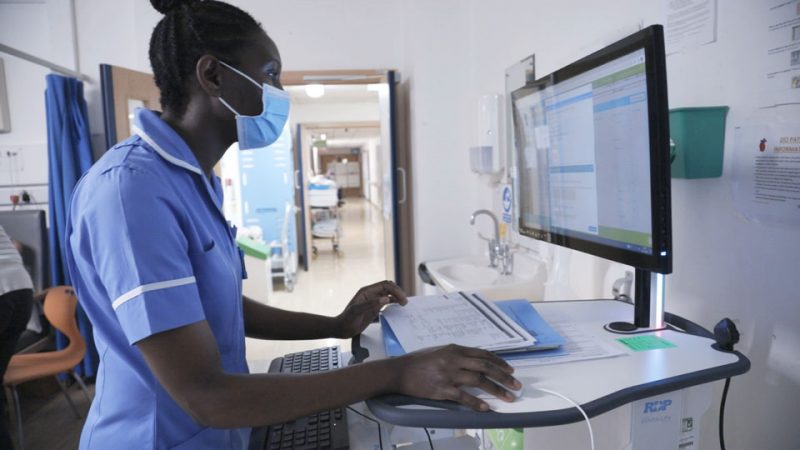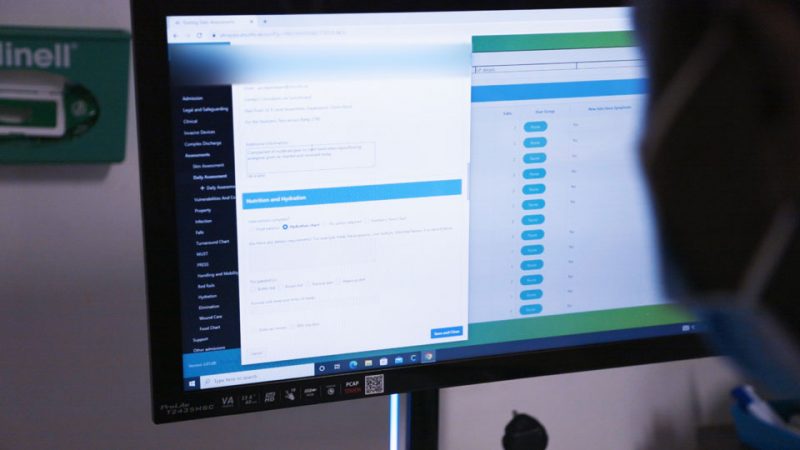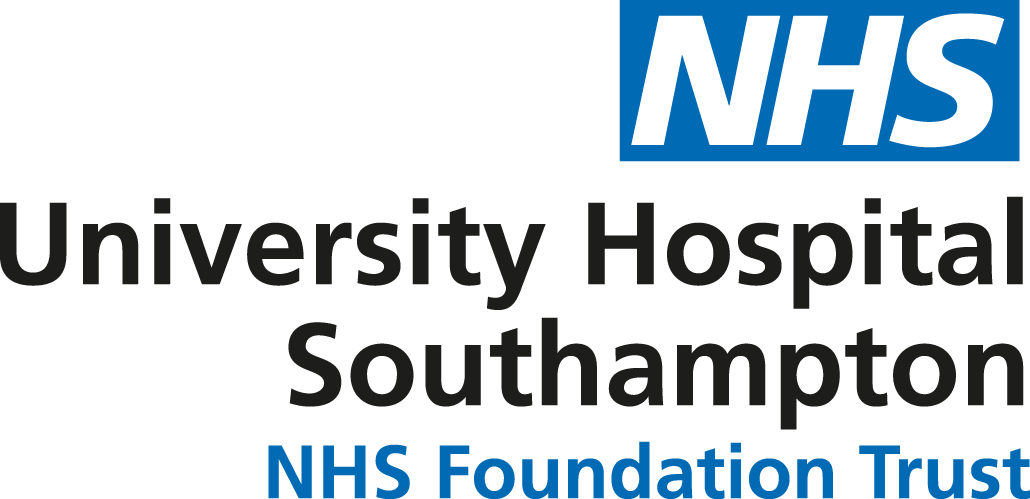Going paperless on the ward
A newly introduced, electronic Inpatient Noting system is rolling out across wards in University Hospital Southampton (UHS) as part of the transformation to paperless documentation of patient care.
Chief Nursing Informatics Officer Sarah Bradburn reports on this innovation and reflects on the challenges and successes in the way clinical and digital staff work together to introduce major changes in working practices.

A nurse using UHS’s digital Inpatient Noting system on the ward
What is Inpatient Noting?
Inpatient Noting is a secure, online app that contains the core nursing assessments and care plans for patients, which is replacing the paper versions that have been traditionally used on the wards.
It has been built in-house by UHS digital developers working with clinical staff.
When patients are admitted on the ward, the nursing staff will be able to complete the core nursing assessment forms and care plans such as the skin assessment, daily assessment, vulnerabilities and concerns, infection, falls, MUST, PRESS, handling and mobility, bed rails, hydration, elimination, wound care, food chart, turnaround and body maps.
Invasive devices, patient property, therapy SOAP notes and Trauma rehab prescription (adult) are also available on Inpatient Noting.
It is bringing us another big step closer to paperless working on the wards.
Benefits for staff
There are so many benefits for staff in moving from a paper-based system to a digital one
With digital Inpatient Noting we are able to provide reminders of when care plans and assessments are due. Staff on the wards no longer have to find the paper versions. It is easier to read and more than one person can access the notes and document care given at the same time.
Working digitally also means less scanning and fewer paper forms being purchased, so it’s a saving on the budget and on our environment.
Having the patients’ care plans and assessments on the computer also means that audits are a lot quicker.
One of the ward sisters said that the weekly forms audits that once took three hours now takes about 10 minutes and when completing AERs and complaints have become easier and quicker too as the information is right in front of you.
You no longer have to go searching for the notes on the ward or check the scanned versions.
Watch nurses talk about their experiences of using digital Inpatient Noting
Patient benefits
We are already hearing from the nursing and health care assistants who are using Inpatient Noting, that it is saving them time. Time saved to care.
Inpatient Noting also provides a lot of information about the care we provide, which means we will be able to access the information to look at areas that need more education, and therefore improve our patients’ experience.
For me, for something to be successful, you must involve the client and here at UHS that means involving the staff that will be using the digital system.
Collaboration in development
Developing the Inpatient Noting system has been a truly collaborative process between UHS digital project managers, IT developers and clinical staff, and the success we have had in developing the system owes a lot to that approach.
At UHS we are very lucky to have extremely motivated and driven project managers and IT developers who have expertly led the project by gathering all the necessary information and then building what it could look like in a digital system.
Nursing and therapy subject matter leads have been involved along the whole journey.
The digital project manager made sure that for every nursing document, there was a nurse or therapist assigned to make sure it was fully approved and had clinical sign off.
Thanks to the nurses’ and therapists’ involvement, the development team have been able to build and design the online forms in a way that are simple to use.
Working together from the beginning of a project will increase the chances of it being a success and reduce the length of the project.

The Inpatient Noting system includes reminders as well as daily assessments
One of the sisters on our pilot ward admitted to me that she was opposed to moving over to the digital forms as she felt paper worked, but now she admits that digital is better and it is saving her time.
Resistance to change
You have to accept that not everyone will be receptive to change, and some will find it easier than others, and that is okay. Some will run towards and happily embrace Inpatient Noting, some will be positive but cautious and some will be reluctant and negative.
I can remember a time when the staff on the pilot ward were asking for it be taken away, but under the great leadership of their ward leader and their matron they stuck at it.
If you were to ask them now if they prefer paper nursing notes or the digital system, they will admit that the digital forms are better.
I believe that if the staff on the ward receive adequate good quality teaching and support and understand the benefits of Inpatient Noting then that will make the transition smoother.
We achieved this by implementing a team of floorwalkers who trained the staff for two weeks before we went live and then they walked the wards for three weeks once they went live to support the staff by providing extra on the spot training and they were also able to feedback to the project team any issues they may have found
Lessons learned
As the Chief Nursing Informatics Officer, I feel incredibly proud and excited to see Inpatient Noting being used by the staff on the ward. I know the hard work that has gone into building it.
It has been designed and built in partnership with staff on the wards, specialist nurses, therapists, digital project managers, and developers, which gives me confidence in the Inpatient Noting application.
I would say that for any other team about to embark on a digital project the best approach is to make sure you work closely with and involve the staff that will be using the digital system and then test, release, listen, learn, fix, repeat.
Make sure you invest in the time, people and hardware, and let the staff who are using it tell the story of their journey and experience using the new digital system.
At the end of the day, they are the best evaluators and will be the best promoters if you get it right.
